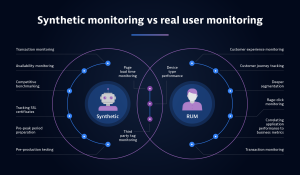In today’s competitive business environment, customers demand seamless user experiences. As businesses compete for customer loyalty, it’s critical for organizations to harness tools that help them see how users interact with their services. By understanding the difference between two such tools, synthetic monitoring vs. real user monitoring, teams can use them to develop high-performing applications and services that deliver loyalty-building user experiences.
Although both of these development and testing practices examine user behavior, they have distinct—and complementary—goals. Here, we’ll explore synthetic monitoring and real user monitoring, and how both help to deliver user experiences that win—and keep—customers.

What is real user monitoring?
Real user monitoring (RUM) is a performance monitoring process that collects detailed data about users’ interactions with an application. RUM gathers information on a variety of performance metrics. If you collect data on page load events, for example, it can include navigation start (when performance measuring begins), request start (when the user initiates a server request), and speed index metrics (measure page load speed).
A user session, also known as a click path or user journey, is a user’s sequence of actions while working with an application. User sessions can vary significantly, even within a single application. RUM collects data on each user action within a session, including the time required to complete the action. As a result, IT pros can identify patterns and where to make improvements in the user experience.
Ideally, a RUM tool would record all user actions to capture the complete picture of a user’s experience. In reality, only highly scalable RUM solutions can collect data on all user actions, while less scalable tools must sample user actions and make inferences from partial data.
Benefits and challenges of RUM
Real user monitoring is great for providing real metrics from real users navigating a site or application. The benefits of RUM include the following:
- Access to data from real end users across various applications, services, and environments.
- The ability to collect a diverse set of data points for every user accessing the application or services.
- Customizable variables to track, collect, and evaluate application-specific data points using JavaScript.
- Real-time monitoring of user application and service interactions.
- Enhanced issue remediation with the option to watch visual session replays of users interacting with web services or applications.
RUM, however, has some limitations, including the following:
- RUM requires traffic to be useful. If teams use RUM in a pre-production environment, it’s challenging to get useful information. Because teams use pre-production environments for testing before releasing an application to end users, they have no access to real-user data.
- RUM works best only when people actively visit the application, website, or services.
- In some cases, you will lack benchmarking capabilities. Because RUM relies on user-generated traffic, it’s hard to indicate persistent issues across the board.
- RUM generates a lot of data. RUM’s attention to detail results in a more accurate diagnosis of end-user issues and experiences. However, the volume of data it generates can make responding to specific issues cumbersome and difficult to prioritize.
What is synthetic monitoring?
Synthetic monitoring, also known as synthetic testing, is a performance monitoring practice that emulates users’ paths when engaging with an application. It uses scripts to generate simulated user behavior for different scenarios, geographic locations, device types, and other variables.
After collecting and analyzing this valuable performance data, a synthetic monitoring solution keeps tabs on application updates and how an application responds to typical user behavior. For example, synthetic monitoring can zero in on specific business transactions, such as completing a purchase or filling in a web form. This gives teams crucial insight into how an application is performing.
Benefits and challenges of synthetic monitoring
Synthetic monitoring is good at catching regressions during development lifecycles, especially with network throttling. The benefits of synthetic monitoring include the following:
- Simulation of entire user journeys in a controlled application environment.
- The ability to identify application performance issues and potential issues by running interval tests.
- Customized tests based on specific business processes and transactions — for example, a user leveraging services when accessing an application.
- Complex transaction and process monitoring that might have deeper dependencies. For example, in e-commerce, you can validate and test checking out a shopping cart.
- Application or service lifecycle testing at every stage. This includes development, user acceptance testing, beta testing, and general availability.
- Geofencing and geographic reachability testing for areas that are more challenging to access. For example, the ability to test against a wireless provider in a remote area.
- Performance testing based on variable metrics (i.e., connectivity, access, user count, latency) of geographic regions.
Much like RUM, however, synthetic monitoring has its limitations. Here are some drawbacks:
- Synthetic monitoring can be too predictable. In synthetic monitoring, tests and results are generated in a controlled and predictable testing environment. Because synthetic monitoring doesn’t track real users, you’ll have challenges gauging what an end user might experience in the event of an unpredictable variable.
- Tools may be limited. Depending on the vendor or technology you work with, you may not be able to integrate existing tools with scripts for your tests.
- The range of costs and feature sets can vary widely for synthetic monitoring tools. It’s recommended to work with partners that can deliver RUM and synthetic user monitoring to deliver the most value.
Synthetic monitoring vs. real user monitoring: Which do you need?
The real answer may not be one or the other. Instead, when working with websites, applications, or services, you may need both. While synthetic monitoring allows you to create a consistent testing environment by eliminating the variables, both RUM and synthetic monitoring provide feedback about site, application, or service performance. The strength of both solutions comes when you combine them.
By using synthetic monitoring and RUM together, you can thoroughly investigate specific user issues, and discover and resolve shortcomings. Furthermore, both tools provide full visibility into user and service performance. Using both, you can gauge how fast a site or service needs to be to ensure user satisfaction and to deliver optimal performance.
Together, RUM and synthetic monitoring can accomplish the following:
- Help correlate business requirements with performance levels by providing the performance data you need to analyze the end-user experience.
- Pinpoint challenges before active users access your website or services by identifying problems, such as configuration issues, so you can fix them before users log on.
- Use data from one engine to facilitate testing for the other. For example, you can use RUM data to provide real use cases you can use for simulation in synthetic monitoring for detailed testing in a staging environment.
Finally, combining RUM and synthetic monitoring data can make troubleshooting faster and easier. For example, real-user monitoring metrics might reveal a user performance issue that you can then apply to synthetic testing to replicate the issue by exercising the same transaction across several different variables.
Synthetic monitoring and RUM—better together
The bottom line? Both RUM and synthetic monitoring tools provide insight into every step within the application delivery chain and life cycle.
Working with both RUM and synthetic monitoring creates a healthy long-term solution to support the best possible user experience. While using one or the other tool will undoubtedly help to analyze performance in different ways, the true power comes when you use them as a complementary toolset. The result is a more comprehensive and robust monitoring strategy that will have a longer-lasting impact on user performance and experience.
To learn more, join the Dynatrace Performance Clinic as they outline monitoring in a digital era.




Looking for answers?
Start a new discussion or ask for help in our Q&A forum.
Go to forum